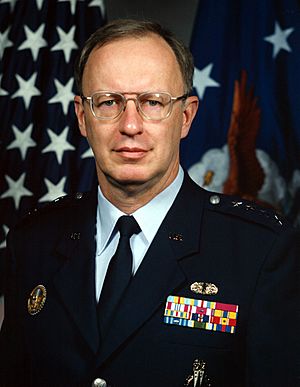John A. Gordon facts for kids
Quick facts for kids
John A. Gordon
|
|
|---|---|
 |
|
| 2nd United States Homeland Security Advisor | |
| In office April 30, 2003 – July 28, 2004 |
|
| President | George W. Bush |
| Preceded by | Tom Ridge |
| Succeeded by | Fran Townsend |
| Undersecretary of Energy for Nuclear Security | |
| In office June 29, 2000 – June 28, 2002 |
|
| President | Bill Clinton George W. Bush |
| Preceded by | Position established |
| Succeeded by | Linton Brooks |
| 20th Deputy Director of Central Intelligence | |
| In office October 31, 1997 – June 29, 2000 |
|
| President | Bill Clinton |
| Preceded by | George Tenet |
| Succeeded by | John McLaughlin |
| Personal details | |
| Born |
John Alexander Gordon
August 22, 1946 Jefferson City, Missouri, U.S. |
| Died | April 19, 2020 (aged 73) Columbia, Missouri, U.S. |
| Education | University of Missouri, Columbia (BS) Naval Postgraduate School (MS) New Mexico Highlands University (MA) |
| Military service | |
| Allegiance | |
| Branch/service | |
| Years of service | 1968–2000 |
| Rank | |
| Commands | 90th Strategic Missile Wing |
| Awards | Legion of Merit |
John Alexander Gordon (born August 22, 1946 – died April 19, 2020) was an important American leader. He was a general in the U.S. Air Force. He also held key jobs in the government. These included being the Deputy Director of the CIA. He also served as the President's Homeland Security Advisor from 2003 to 2004.
Contents
Military Service and Leadership
John Gordon joined the Air Force in 1968 through a special program called Reserve Officer Training Corps. Early in his career, he worked on improving important missiles like the Minuteman Intercontinental Ballistic Missile (ICBM). He also helped develop the Peacekeeper ICBM.
He was a planner for the Strategic Air Command. He also worked with the U.S. State Department on political and military matters. Later, he led the 90th Strategic Missile Wing. This was the only unit that used Peacekeeper ICBMs.
Gordon also worked with the National Security Council. Here, he focused on defense and arms control. He helped finish the START II negotiations, which were about reducing nuclear weapons. Before he became the Deputy Director of the CIA, he helped the Air Force plan for the future. He retired from the Air Force on August 1, 2000.
Important Roles After the Military
After leaving the Air Force, John Gordon continued to serve his country. He was chosen to lead the National Nuclear Security Administration. This agency is in charge of the U.S. nuclear weapons program. He held this important role from June 2000 to June 2002.
Next, he became the Deputy National Security Advisor for Combating Terrorism. This means he helped the President deal with terrorism. From April 2003 to July 2004, he served as the Homeland Security Advisor. In this job, he helped protect the country from threats at home.
In September 2004, he was honored by the Naval Postgraduate School. He was added to their Hall of Fame. After leaving public service, he joined several boards and task forces. These groups worked on national security and other important topics. John Gordon passed away on April 19, 2020, at 73 years old.
Education and Learning
John Gordon was a dedicated student throughout his life. He earned several degrees from different universities.
- 1968: He earned a Bachelor of Science degree in physics from the University of Missouri.
- 1970: He received a Master of Science degree in physics from the Naval Postgraduate School in Monterey, California.
- 1972: He earned a Master of Arts degree in business administration from New Mexico Highlands University.
- He also completed several military training courses. These included the Squadron Officer School and the Air War College.
Major Awards and Honors
John Gordon received many awards for his service. These awards recognized his important contributions and leadership.
Images for kids







